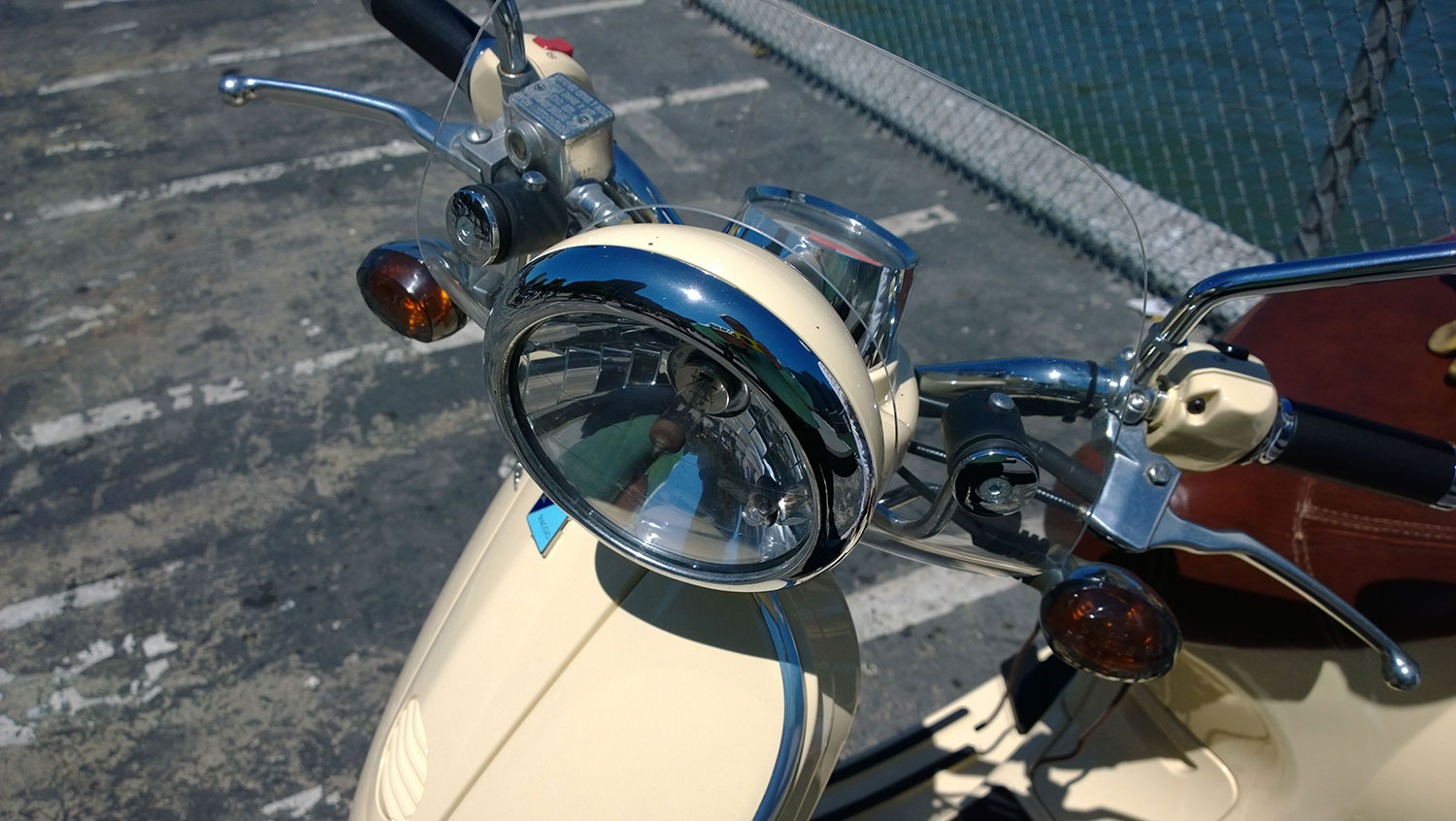Since 2010, when Microsoft released its all-new Windows Phone smartphone software, all of the handsets that have run it have had one thing in common. The most notable thing about each of them has been that they’ve run Windows Phone, an underdog of an operating system that departs from Apple’s iOS and Google’s Android in multiple ways, some of which are pretty clever.
And then there’s Nokia’s Lumia 1020. Like all new Nokia smartphones, it’s a Windows Phone 8 model. But that’s a secondary fact. The most interesting thing about the 1020 is that it packs a breakthrough camera, one so good that it’s as reasonable to think of this gadget as a camera that makes calls as a phone that takes pictures.
People — myself included — got excited when Nokia announced the 808 PureView last year, a phone which offered similar camera capabilities but ran the moribund Symbian operating system. With the Lumia 1020, the technology arrives in a phone you might actually want to buy. It’s available from AT&T for $300 with a two-year contract, or $660 without any strings attached. That’s for a model with 32GB of non-upgradable storage.
Like other Nokia phones I’ve used dating back to the last millennium, the Lumia 1020 is made of sturdy, high-grade plastic, feeling more like a solid hunk than a shell stuffed with electronics. (At 5.57 oz., it’s noticeably heavier than the iPhone 5, Samsung Galaxy S4 and HTC One.) It’s got a 4.5″ AMOLED screen — roomy, but not remarkably so by today’s standards.
Even the most casual glance at the 1020 will tell you that it’s an uncommonly photo-centric phone. From the back, it looks more like a slender point-and-shoot camera than a smartphone, with a circular protrusion containing the lens and flash. You certainly know the bulge is there when you cradle the phone in your fingers; prospective owners should head to an AT&T store and fondle the phone for themselves before plunking down any money. But I didn’t find it particularly off-putting — and hey, if you’re sufficiently jazzed about owning a phone with an exceptional camera, you might even see it as a lumpy badge of honor.
The bump is there for a reason: Everything about the 1020’s photographic hardware represents an upgrade over even the more-than-decent cameras sported by most major smartphones of 2013.
The 1020 has a camera capable of capturing a jaw-dropping 41 megapixels of resolution — it says so right below the lens — but the maximum resolution of photos you can shoot is only 34 megapixels.
Wait, did I just say “only 34 megapixels?” That still a ridiculously high count compared to the cameras on other current phones, which tend to max out at between 8 and 13 million pixels. It’s far more than you’ll ever need for the reason that most people think you want more pixels: for more detail, especially in printed photos.
For pictures you plan to post on the web, 34 megapixels is just plain pointless. And, at the same time, amazing. The pictures are too expansive to fit on the screen at full resolution, but they capture details that would devolve into blocky pixels in photos from other smartphones. You’ll see what I mean if you click on the image below to see it in its full 4352-by-7712 glory.
(Incidentally, you can’t upload 34-megapixel photos directly from the 1020 to Facebook, Twitter, Microsoft’s SkyDrive or other online repositories. Instead, they get 5-megapixel versions, which is just fine. You copy the 34-megapixel monsters off the phone and onto your PC using a USB cable, whereupon you can do with them what you will.)
All those pixels the Lumia’s sensor can collect do deliver one big benefit: You can zoom in — or crop after the fact — without killing the resolution. The 1020’s digital zoom, which you engage by swiping up while composing a picture, is the equivalent of a 3X optical zoom on a real point-and-shoot camera. It’s the first smartphone zoom I’ve encountered that isn’t worthy only of being ignored.
And the phone’s optical excellence isn’t just about megapixels. Its imaging sensor measures .67″ diagonally, compared to .31″ for the one in the iPhone 5; bigger sensors take better pictures and shoot better video, particularly in low light. The 1020 also has a xenon flash, an upgrade over the dinky, harsh LED ones that are standard fare in smartphones.
See below for some of the photos I took with the Lumia 1020. I smooshed them down to fit on this page, but didn’t otherwise tweak them. You can click to see higher-resolution versions.
Here’s something a tad confusing: The Lumia 1020 comes with Windows Phone 8’s standard camera app, but you probably won’t want to use it. I took the above snapshots with Nokia Pro Cam, a custom app that lets you choose to save either 5-megapixel versions of your photos or both 5-megapixel and 34-megapixel ones. Pro Cam lets you focus manually and fiddle with settings like exposure compensation, white balance and ISO, like you can with a camera that doesn’t happen to double as a phone.
Another Nokia app, Smart Cam, shoots multiple copies of the same photo and then lets you perform tricks similar to the ones available with Samsung’s Galaxy S4: It will automatically choose the best shot of the bunch, for instance, or let you edit in faces from different photos so everyone in a group portrait has just the right expression. As with Samsung’s equivalent features, Nokia’s are gimmicky good fun, but I’m skeptical that many folks will use them often.
The Lumia 1020 doesn’t need any gimmicks. I took lots of nifty pictures with this phone — not nifty smartphone pictures, but nifty pictures period. There isn’t another phone on the market that’s a more serious photographic tool.
But the thing is, great camera technology alone does not guarantee a great camera experience. I didn’t have as much fun taking pictures with the 1020 as with handsets such as the iPhone 5 and Galaxy S4 — or, come to think of it, as with a top-notch point-and-shoot. In certain respects, the phone’s camera features were downright frustrating.
A few of my quibbles:
- Like other Windows Phones, this Lumia sports a feature every phone should have: a dedicated shutter button in the spot where you’d expect it to be on a point-and-shoot camera. When the phone is powered down, you can press this button to turn it on and go directly into camera mode. But it takes what feels like a loooooong time — a little over four seconds, in my experience — before you’re in Camera Pro and ready to shoot. (You know a feature is sluggish when the operating system has to display a “Loading…” message while it’s starting up.)
- Similarly, pressing the shutter button results in an achingly long pause, with a “Saving” message and a little animated flourish. It’s impossible to fire off a bunch of photos in quick sequence.
- The icons in Pro Cam for functions such as the flash are microscopic. When you tap one, a giant identifier pops up — but it’s on the lower left-hand corner of the screen. If you hold your phone in your left hand — as southpaws (like me) often do — your palm will obscure the label.
- Pro Cam’s menu is needlessly counter-intuitive. Do you tap the item “review on” to turn on the review feature? Nope — it’s telling you that it’s already enabled. You tap “review on” to toggle review off.
Let’s see. I mentioned that this is a Windows Phone, didn’t I? Every time I spend time with one, I come away impressed with the basics of its novel interface — tiles and swipe-able screens, which are at least as efficient a way to navigate your information and world as anything in iOS or Android. They make Windows Phone a pleasant place to be.
Traditionally, all reviews of Windows Phones must carp about the platform’s skimpy selection of apps. As more and more major titles have become available, that downside has become a little less daunting. But holes remain, and users still suffer indignities unknown to iPhone and Android types. Microsoft and Google are squabbling over the YouTube app for Windows Phone, for instance, and using the third-party Instagram clones available for Windows Phone can be a crapshoot.
In the end, Windows Phone 8 remains a dark-horse choice in the smartphone wars, but not an irrational one. Still, I’d only recommend the Lumia 1020 to people who are genuinely enthusiastic about the prospect of using Windows Phone; it would be a mistake to adopt it half-heartedly.
As for the overall bottom line on this phone, its camera makes it a landmark, but the slow, clumsy software gets in the way of picture-taking bliss. Its annoyances seem solvable to me, though. And an update to this phone that fixed them — let’s call it the Lumia 1120 — would be more usable and lovable.










